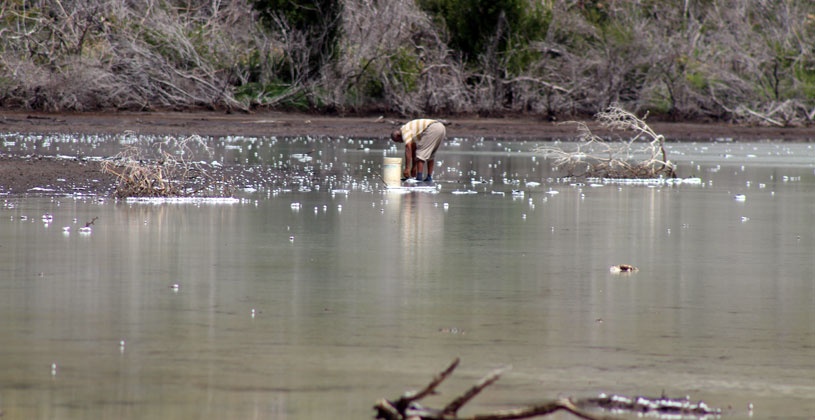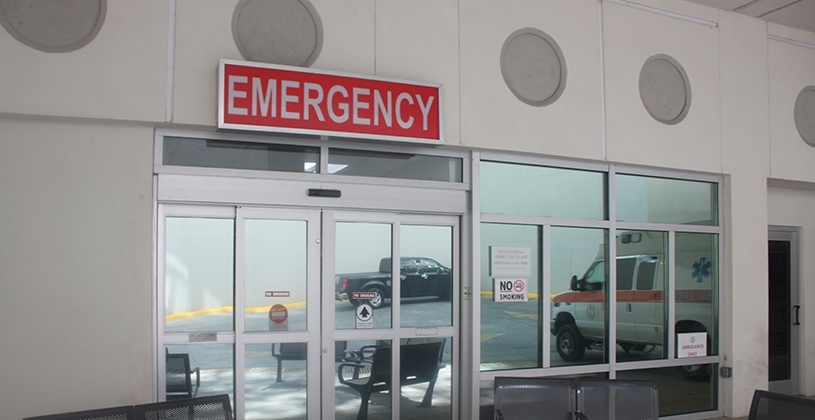
(PLTM) - A large quantity of salt was discovered in a pond on Beef Island last week, something that has not happened to that extent in years, and Hurricane Irma could have played a role in this development.
While there are a few salt ponds across the BVI, Salt Island is predominantly known for salt harvesting.
Last Friday, March 15, BVI Platinum News was informed of an unusual—albeit not unprecedented—happening on Beef Island. A pond which has perhaps not produced salt in the lifetime of some younger residents, was found to have a considerable accumulation of salt banks. So much so, that when this publication visited the location that day, an individual was found harvesting the salt crystals.
“It’s the first time in a long, long time that something like this happened,” a senior gentleman commented, as he speculated that the hurricanes of 2017 may have caused salt water to be deposited into the pond, which has no connecting channel to any salt water source.
To better understand what may have caused the phenomenon, this publication ventured to the Ministry of Natural Resources and spoke to Environmental Officer, Ms. Angela Burnett, who confirmed that the theory of Hurricane Irma causing the salt water to be deposited in the pond could be correct.
The Science Behind The Salt
“There is a possibility that an ‘overwash’ event, potentially during the hurricane, may have contributed some additional salt water to the pond that may have made it more saline than usual, but we don’t know for sure,” she stated, as she related that the discovery has been reported and is being discussed within the Ministry.
An overwash is the flux of water over dunes or beach crests, such as those between the surrounding waters and the pond, during a storm event.
Ms. Burnett added that there are other possibilities that the salt also could have formed naturally as a result of the changing climate in recent years, as she explained how salt is formed.
[gallery]“Basically, it’s a natural process. There are several salt ponds across the territory that would have that phenomenon of actually salt being crystalised and produced. Where it’s most commonly found is a salt pond on Salt Island, and there’s actually a strong history and culture of going to harvest the salt at a particular time of year,” she said.
She continued, “…Of course, the formation of the salt would have to do with a number of factors, including things like the salinity at the time, temperature and how quickly the pond might evaporate because it’s an evaporation process that would actually lead to the salt crystalizing and forming at the edge.”
According to the Environmental Officer, the BVI is currently experiencing the dry season, with very low rainfall, which can result in a lack of fresh water.
“So, if you have minimal rainfall and if you have high atmospheric temperatures, and then those two things will go together to create high levels of evaporation,” she noted.
“That particular pond, it’s perhaps not frequented very often by the public. So, it may be that these events are happening more frequently than we actually become aware of, because of the lower visitation to the area,” Ms. Burnett opined.
Climate Change At Work
She strongly believes that the recent climate conditions are the key reasons behind the phenomenon.
“I think it’s more due to the factors I was just explaining. We’ve had very little rainfall and temperatures are quite high. Whenever you have those two factors combining, you have higher rates of evaporation and it’s a simple evaporation process that leads to the formation of the salt,” she stressed.
Ms. Burnett is an Environmental Officer with a keen focus on climate change, and she explained that climate change has a connection to the second theory on the cause of the salt’s formation.
“As you know, there’s a general trend of warming that we’re experiencing globally as a result of climate change. So, we will see hotter days, hotter nights. Maybe our dry season becoming more drier and more hot,” she stated.
“There are two general trends, one of warmer temperatures and we’re also seeing a trend in rainfall where there is an overall drying trend. So, as a region and this sub-region in particular, we’re experiencing a reduction in the total amount of rainfall, but there are also shifts, not just in seasonality, but in the intensity of events. So, while we are having less overall rainfall, paradoxically, we are also having a higher incident of flood events,” she shared.
Ms. Burnett further added, “So when it does rain, it tends to come in shorter, more intense spurts. So, you sort of have these two seemingly opposing trends happening at the same time.”
Monitoring
According to Ms. Burnett, “This is the first incident at this scale that is being spoken of in recent times, but maybe things like these may become more frequent as we continue to have these trends.”
She is therefore encouraging residents to pay attention to the environment and help the Ministry to track such developments and phenomena in the environment.
“It will be something interesting to track. One of the things we want to encourage at the Ministry is sort of the idea of citizen science. So, actually having members of the society becoming more active to monitor the environment and helping to track changes in the system over time because we can’t be everywhere in the field all the time,” she stated.
